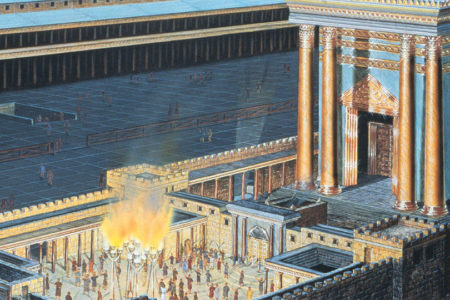Israel’s Travail and Triumph Revelation 12
Satan’s attempts to annihilate the Jewish people throughout the centuries are well documented in biblical and secular history. Demonically inspired despots like Haman and Hitler, filled with fanatical hatred, have attempted genocide of Jewish people wherever they exist. The Jews often stand before their history in sober silence, stunned and numbed by the unmitigated brutality that their eyes have seen but their minds find difficult to believe. Penetrating pictures of the Holocaust of World War II continually parade across the television screens and minds of America, reminding the viewers of Satan’s relentless attempts to eradicate world Jewry. In this chapter, Satan’s strategy is unmasked as he tries to annihilate Israel during the second half of the Tribulation period, known as “the time of Jacob’s trouble” (Jer. 30:7).
Participants in the Conflict
God drew back the clouds of heaven and revealed to John the participants in this conflict. John saw “a great wonder in heaven—a woman clothed with the sun, and the moon under her feet, and upon her head a crown of twelve stars” (v. 1). Some scholars believe that this is the virgin Mary, but this is impossible because the woman is referred to as a “wonder” (lit., sign) or a symbolic representation of Israel. The same imagery is presented in Joseph’s dream, where the sun, moon, and stars represent Jacob, Rachel, and the tribes of Israel (Gen. 37:9–11). Others believe that the woman represents the church. This cannot be correct either because Israel, not the church, gave birth to the “child” (vv. 2, 5), who is Jesus, the Messiah. Thus, we must conclude that the woman spoken of in this chapter is none other than Israel.
The woman who “being with child, cried, travailing in birth, and pained to be delivered” (v. 2) is not a picture of the virgin Mary giving birth, as some teach. This is a picture of Israel’s travail in bringing forth Jesus the Messiah, as Satan attempted to thwart the birth through the iron heel of Roman oppression and the insanity of a paranoid Herod (Mt. 2:16–18).
John saw “another wonder [sign] in heaven…a great red dragon” (v. 3). The red dragon is a symbol of Satan (v. 9), who is described by various names throughout this chapter. The phrase “a great red dragon” (v. 3) presents him as a cruel monster and a bloody murderer. He is called “that old serpent” (v. 9) because he beguiled Eve in the Garden of Eden. He is called “the Devil” (v. 9) because he is a slanderer. “Satan” (v. 9) describes him as an adversary who opposes God and His program and goes about trying to deceive the whole world. He is called “the accuser of our brethren” (v. 10) because his current work is bringing reproach on believers before God’s throne.
The dragon is described as “having seven heads and ten horns, and seven crowns upon his heads” (v. 3). The seven heads represent seven consecutive evil world empires controlled by Satan and leading up to the revival of the Roman Empire. The ten horns represent the ten-nation confederacy that comes out of the seventh head, which is the revived Roman Empire controlled by Satan during the Great Tribulation. The seven crowns upon his heads indicate the fullness of Satan’s authority and rule over nations, which he will give to the beast (the Antichrist) during the Great Tribulation (13:2). The Antichrist is simply a pawn in the hand of Satan to carry out his devilish program of world supremacy during this time.
At one time the dragon wielded great power and authority over “the stars of heaven” (v. 4). It is clear from other passages that the “stars” represent angelic beings (see 9:1). In the past, Satan and his angels engaged in a heavenly conflict that resulted in their removal from heaven: “And his tail drew the third part of the stars of heaven and did cast them to the earth” (v. 4). The stars are one-third of the angelic host of heaven who followed Satan during his rebellion, when he attempted to usurp authority over God and His throne (see Isa. 14:12–17). Not all of the fallen angels are loose today; some are so vile that they must be chained in hell until the day of judgment (Jude 6; 2 Pet. 2:4). Although Satan’s work is limited to the atmosphere of the earth, he still has access to God’s throne (v. 10; Job 1–2) until he is removed a second time during the Tribulation (v. 9).
“The dragon stood before the woman [Israel]…to devour her child [Jesus] as soon as it was born” (v. 4). Satan recognized that Jesus’ birth was a threat to his illegal possession and control of the earth. It was prophesied that Satan would try to cut off the woman and her seed long before Israel was a nation (Gen. 3:15). He tried to cut off Christ’s lineage by the death of Abel (Gen. 4); pollute the godly line of Seth (Gen. 6); produce a pseudo-son of promise in Ishmael (Gen. 16); destroy Israel in Egypt (Ex. 1) and in Persia (Est. 3:8–15); and kill Christ in Bethlehem (Mt. 2:16), Nazareth (Lk. 4:28–29), and at His crucifixion (Mt. 27:33–50). But Christ defeated Satan through that very crucifixion (Heb. 2:14).
Clearly the “male child, who was to rule all nations with a rod of iron” (v. 5), is Jesus Christ. After His birth, ministry, death, and resurrection, He ascended back to heaven and is seated on the right hand of God, where Satan cannot touch Him.
Unable to destroy Christ, Satan centered his attack on the woman. “The woman fled into the wilderness, where she hath a place prepared by God, that they should feed her there a thousand two hundred and threescore days” (v. 6). This is the last three and one-half years of the Great Tribulation, when God will protect Israel from being exterminated by the Antichrist.
John saw a fourth person, Michael the archangel (v. 7), whose ministry is to oversee and protect the nation of Israel. The text reveals that “Michael and his angels fought against the dragon [Satan], and…his angels [demons]” (v. 7). Michael gained the victory over Satan and cast him out of heaven onto the earth, thus forever excluding him from access to God (vv. 8–9). This is the first of three judgments on Satan. He will be bound and sealed in the bottomless pit during the kingdom age (20:1–3) and finally cast into the lake of fire to be tormented forever (20:10). The time of this battle, although not given, must be sometime before the middle of the Tribulation. This conclusion parallels Michael’s defense of Israel during the Great Tribulation (Dan. 12:1).
Satan’s removal from heaven produced a victorious hymn of praise. The “loud voice” (v. 10) that John heard has been identified as coming from God, angels, the 24 elders, and the martyred Tribulation saints who are under the altar, although John does not identify the voice.
The hymn is divided into three stanzas. First, praise is given to celebrate the completion of God’s program: “Now is come salvation, and strength, and the kingdom of our God, and the power of his Christ; for the accuser of our brethren is cast down” (v. 10). In other words, Satan is defeated and the earth is delivered from his control as God manifests His strength in establishing the Millennial Kingdom under Christ’s authoritative reign.
Second, praise is offered for the victory of the saints who “overcame him [Satan] by the blood of the Lamb” (v. 11). Christ’s shed blood provided salvation and standing for the saints before God and protected them from Satan’s accusations. They also overcame Satan “by the word of their testimony” (v. 11)—that is, confession of faith in Jesus Christ and His Word before the world. The strength of their commitment is seen in the statement, “they loved not their lives unto the death” (v. 11). These believers were willing to give up their lives for what they believed, even if it meant suffering the violent death of a martyr.
Third, those in heaven are encouraged to “rejoice” (v. 12) over Satan’s expulsion and exile to the realm of the earth, but the earth is given a warning: “Woe to the inhabiters of the earth and of the sea! For the devil is come down unto you, having great wrath, because he knoweth that he hath but a short time” (v. 12). The world, already under the wrath of God, must now face the uncontrollable anger of Satan as he pours out the most irrational hatred possible upon humanity. Why such intense wrath? Satan knows “that he hath but a short time” to accomplish his objectives before being cast into the bottomless pit.
Preserved Through Conflict
Once Satan is cast out of heaven, he will give his full attention to “persecut[ing] the woman who brought forth the male child” (v. 13). His intense hatred of Israel will reach its climax during the Great Tribulation, as he tries to do everything in his power to destroy them. Satan knows that if he can destroy Israel, he can thwart God’s program, keeping it from coming to its ultimate fruition.
But the miraculous hand of God will be upon Israel in the midst of Satan’s plot to destroy them, providing a way for them to escape: “And to the woman were given two wings of a great eagle, that she might fly into the wilderness, into her place, where she is nourished for a time, and times, and half a time, from the face of the serpent” (v. 14). Some scholars believe that this refers to a massive airlift to safety, similar to the May 1991 Operation Solomon, when 14,400 Ethiopian Jews were flown to safety in Israel within 24 hours on El Al Airlines. But the distance is too short and the area too rocky for such an airlift. The term “eagles’ wings” (Ex. 19:4) was used to describe Israel’s flight from Egypt without the assistance of an airlift. The phrase simply indicates that Israel’s flight to safety will be swift and supernatural.
Scripture does not identify the location of “the wilderness” (v. 14) where God will protect and nourish this remnant of Jewish people. Many believe it will be in the area of Edom because this country will escape the wrathful destruction of the Antichrist during the Tribulation (Dan. 11:41). This could well be the place because Christ will come to Edom upon His return to take vengeance on the people of Bozrah and possibly deliver a remnant of Jewish believers (Isa. 63:1–6).
Satan, in one last effort to exterminate Israel, will send “water like a flood after the woman” (v. 15) to destroy her. Israel will be spared from Satan’s tactic when God sends an earthquake to swallow up the flood (v. 16). The text indicates that the water is like a flood, making it difficult to tell if the flood should be interpreted literally or figuratively. Israel has been spared from water twice—at the Red Sea and at the Jordan River. This is most likely referring to Satan’s dispatching a huge army to destroy the fleeing Israelites near the midpoint of the Tribulation (see Ezek. 38–39).
Being unable to destroy Israel will intensify Satan’s anger, causing him “to make war with the remnant of her seed, who keep the commandments of God, and have the testimony of Jesus Christ” (v. 17). These are the 144,000 Jewish people who will become believers during the Tribulation (Rev. 7:4–8) and will be scattered worldwide to testify of their faith in Jesus Christ. They will be victorious over Satan’s attempt to destroy them (14:1–5). Although the Devil will be unable to totally exterminate Israel, two-thirds of the Jewish population will be killed during the Tribulation (Zech. 13:8).
Knowing that his time is short, Satan will step up his persecution of Israel in these latter days. Today, Satan’s strategy to proliferate a legacy of hatred against Israel is like a cancer that never heals. Like the prophets of old, we must warn Israel of their impending travail and stand with the nation as they approach the birth pains of the Tribulation. And, like the prophets of old, we must bring to Israel the comforting message that there is hope and victory in Jesus, their Messiah.







